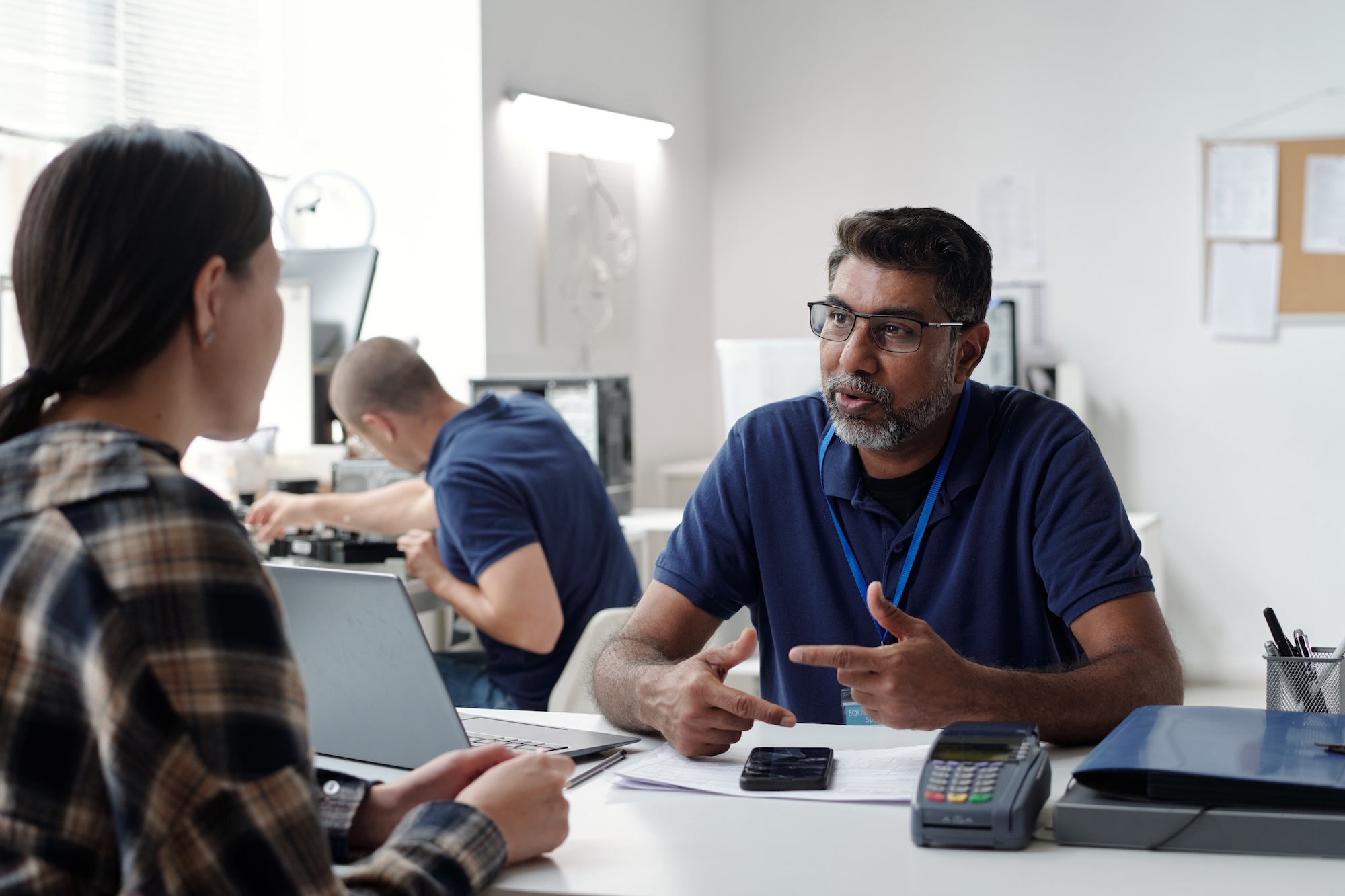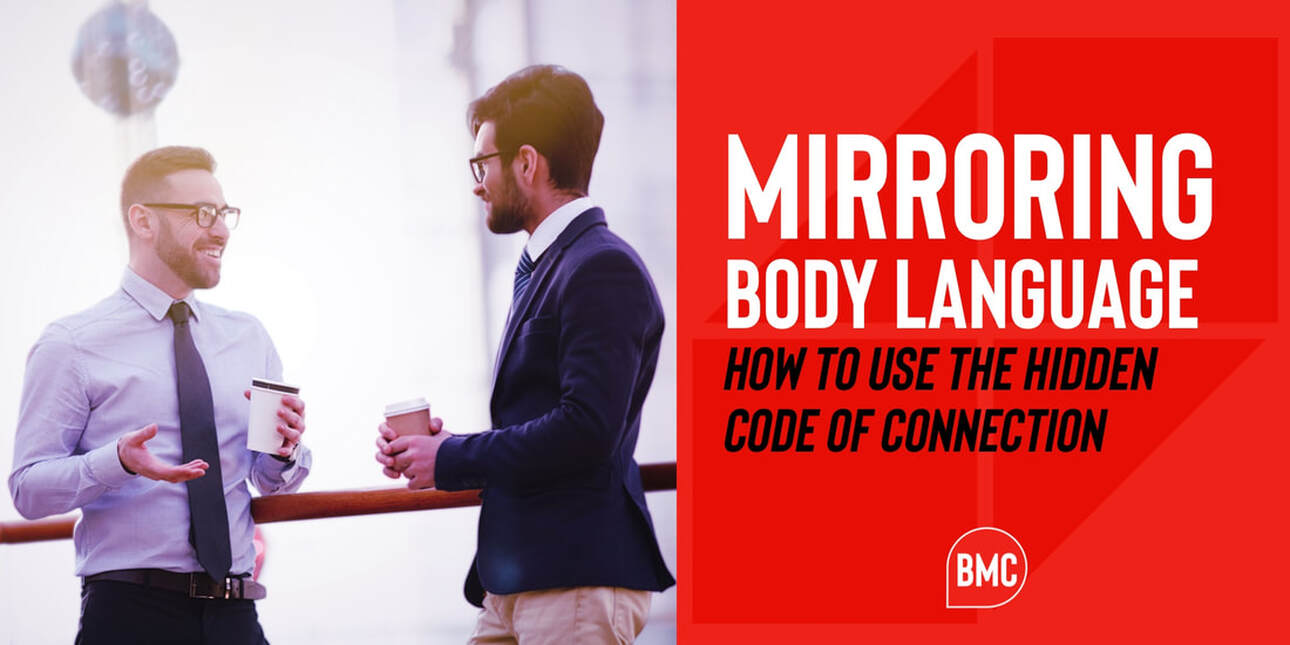
Do you ever get the feeling that you just aren’t connecting with people?
Maybe you’ve noticed a certain coldness from new colleagues, or you’re struggling to build rapport while on a first date.
Perhaps you’ve even seen someone cross their arms, tap their foot, or (gasp!) check their watch while you’re chatting.
Let’s look at an incredible communication hack that you might have been missing: Mirroring.
Mirroring is a fantastic way to supercharge your communication, in many cases without saying a word.
If your goal is to improve your people skills, mirroring is a crucial skill that cannot be overstated.
Studies suggest that people who mirror others are seen as more likable and persuasive.
And those people you mirror will often go out of their way to be more generous and helpful. (Don’t worry, we’ll cover the science on that in a bit.)
So mirroring is pretty freaking important!
And you may have noticed it out in the wild when...
- You notice that they take a drink after you do when out together after work
- You scratch your nose after they do when in a job interview that you really, really want
- You both lean your shoulder against a wall and seem to nod in unison while casually talking in the break room
When you get a glimpse of mirroring, it’s a good indicator that you’re in rapport with that other person.
In this article, we’ll dive deeper into what mirroring is, how you can mirror effectively, and what to avoid doing.
In this article, you’ll learn…
- What mirroring is
- Examples of mirroring in action
- Why people mirror body language
- How you can make mirroring work for you
What is Mirroring?
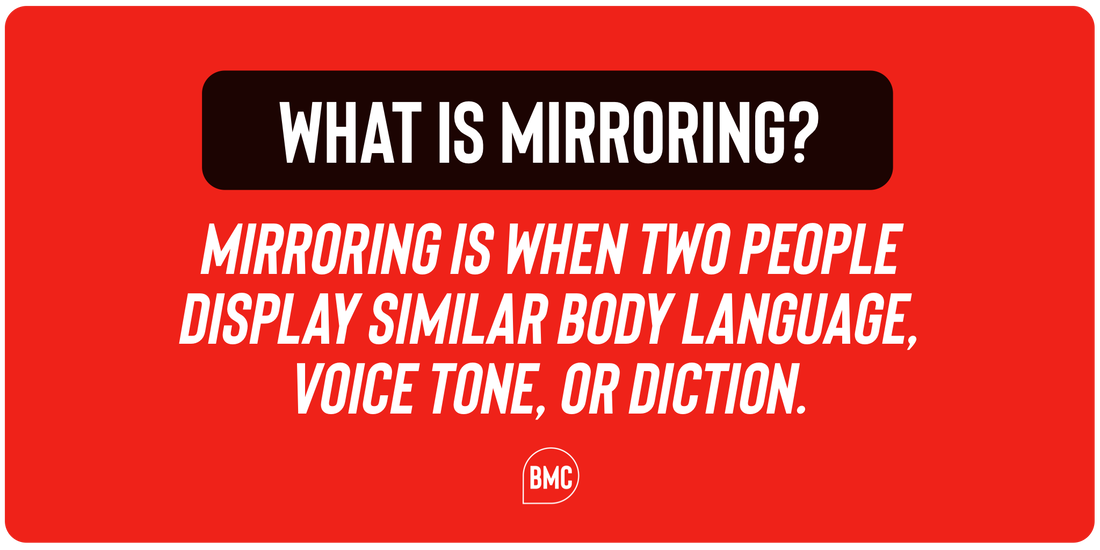
Mirroring is when two people display similar body language, voice tone, or diction.
Mirroring often occurs when two people are in rapport during conversation. The science-y term for this rapport is limbic resonance.
Be careful! We don’t need to go full monkey-see-monkey do to establish rapport.
No need to mimic the other person completely. This will BREAK rapport. Also, mirroring actions don’t have to be exact, only similar.
This is the difference between imitating someone to annoy them, and reflecting their body language back to them.
Why is mirroring so important?
Humans are expert communicators.
We’ve mastered language and technology to convey our thoughts to the world. Even so, there’s a whole other style of communication that we often think about less, yet matters just as much if not more: non-verbal communication.
To quote Ursala the sea witch: and “don’t underestimate the importance of body language!”
Body language and nonverbal communication is a whole hidden language that can go unnoticed and misunderstood if you don’t know what signs to look for.
However, when you do know what to look for, you have a whole new set of tools to read people and determine how the interaction is going.
If body language is your measure of how well the interaction is going, then mirroring is your method to affect the interaction!
The Science of Mirroring Body Language
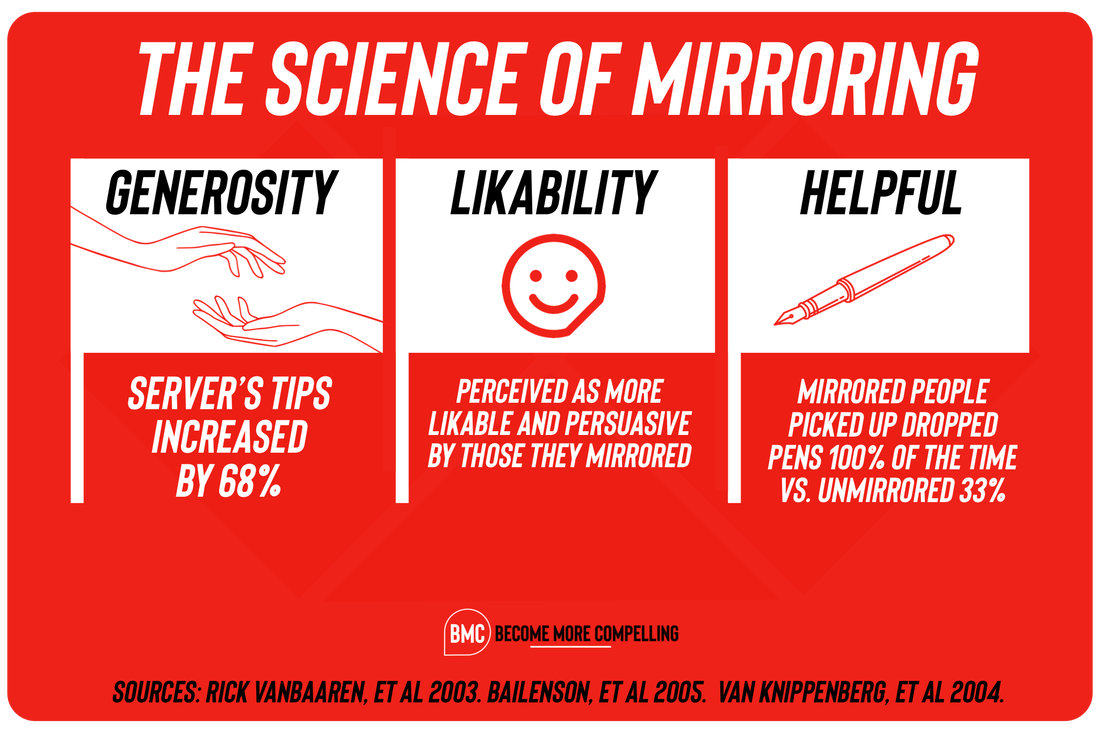
Psychologists have explored mirroring’s impact on social behavior.
Researchers observe that mirroring subconsciously creates a relationship between you and whoever you’re mirroring.
Most interestingly, being mirrored appeared to elicit pro-social behaviors like the following:
- Generosity: A 2003 study by Rick vanBaaren and others found that servers who mirrored their customers saw their tips increase by over 68%. vanBaaren and colleagues (2004) also found that mirrored participants were more likely to give to charity when prompted.
- Likability: Bailenson and colleagues (2005) found that people who mirror others are perceived as more likable and persuasive by those they mirror.
- Helpfulness: Van Knippenberg et al. (2004) found that people who had been mirrored picked up dropped pens 100% of the time vs. people who had not been mirrored (33%).
Put simply: mirroring others encourages positive social behaviors that make moving through the world easily.
Many socially skilled people use mirroring consciously and unconsciously to create rapport. When you mirror others, you create an empathetic bond that signals a connection.
If you don’t mirror others, then other people won’t feel that same connection with you. They may not even be able to identify why, but they’ll feel the distance.
Action step: The next time you’re at a restaurant, watch servers and restaurant staff interact with customers, or glance at other dining patrons. Notice any examples of mirroring in action. Can you figure out who’s mirroring who?
Who’s fronting? Fronting before mirroring
Mirroring doesn’t happen immediately.
Typically, you’ll need to start the process of building rapport with a new person before you notice any mirroring.
This is why small talk is so important! Without an initial conversational spark, it’s nearly impossible to build conversational rapport.
And remember that mirroring occurs when two people are in conversational rapport: no rapport, no mirroring. Want to build rapport? Check out this article on building rapport here!
One of the best positions to make mirroring happen is through fronting.
Fronting is a way to communicate with your entire body that the person in front of you has your full attention.
Fronting puts the emphasis on the word front: from your face to your toes, you should square your body so that you face your conversational partner.
Keep your body language pointed towards your partner, subtly reinforcing that they are your whole world right now!
The face-to-face angle is intense, but it’s also the most effective for building on an existing rapport.
Imagine a high-pressure job interview.
Your future boss opens their office door, greets you, and leads you to the conference room.
The walk to the conference room is a great opportunity to build initial rapport:
- “I love this new location”
- “Have you talked to <some mutual friend> lately?”
These are neutral while presenting you positively.
Then your future boss takes a seat on one side of the conference tables and indicates that you should sit.
Do you sit right next to them? How about diagonally?
Not if you want to front!
If you can, you sit right across from your future boss with your shoulders squarely facing them.
More likely than not, in an interview, you will subconsciously mirror the person in authority.
Facing them directly sets you up as a perfect mirror, and gets you in the right position to build rapport.
Look at the following two stock images: can you identify which one features fronting?

Mirroring Body Language Examples
These are some of the most commonly mirrored aspects of body language.
When mirroring someone’s body language (or looking for signs of mirroring), look for some of these, first!
Keep in mind that one piece of evidence is a coincidence– we’re looking for a pattern.
If everything about an individual’s body language says they’re engaged, except that they’re struggling with eye contact, you can rely on a cluster of positive data points.
Look at the following mirroring examples to demonstrate!
Mirroring Body position:
This is a big one, especially while seated.
- How does the other person sit in their seat?
- Are they perched on the edge, leaning forward, or leaning back?
- Are they being attentive and open to you with their body language: arms uncrossed, facing towards you?
Some great places to observe body position mirroring is in the Variety “Actors on Actors” series.
Look at the following image of Brad Pitt and Adam Sandler.
Both men have their feet parallel and angled toward the other and both are leaning forward with their forearms on their thighs.
Even without listening to them, we can tell that they’re in rapport!
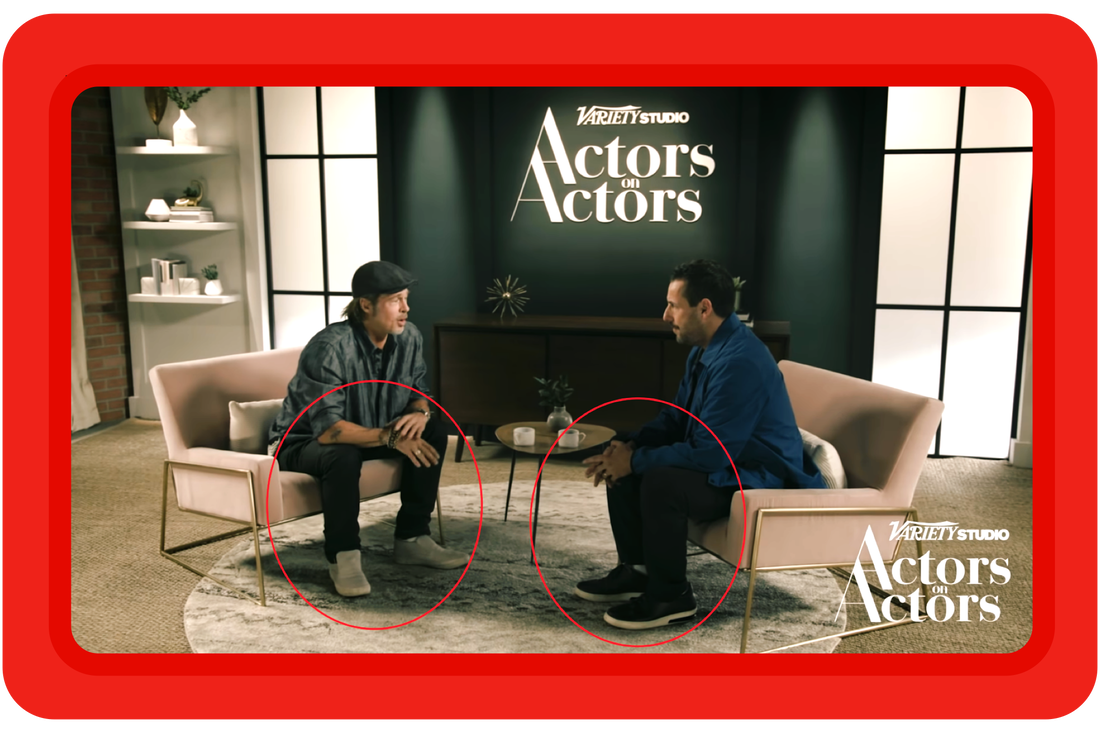
And here’s another screenshot of Scarlett Johansen and Chris Evans’ conversation.
Both actors are leaning back in their chairs, both have crossed legs, and both are laughing.
It’s fairly easy to tell that the two of them are in rapport from how engaged their body position is with one another.
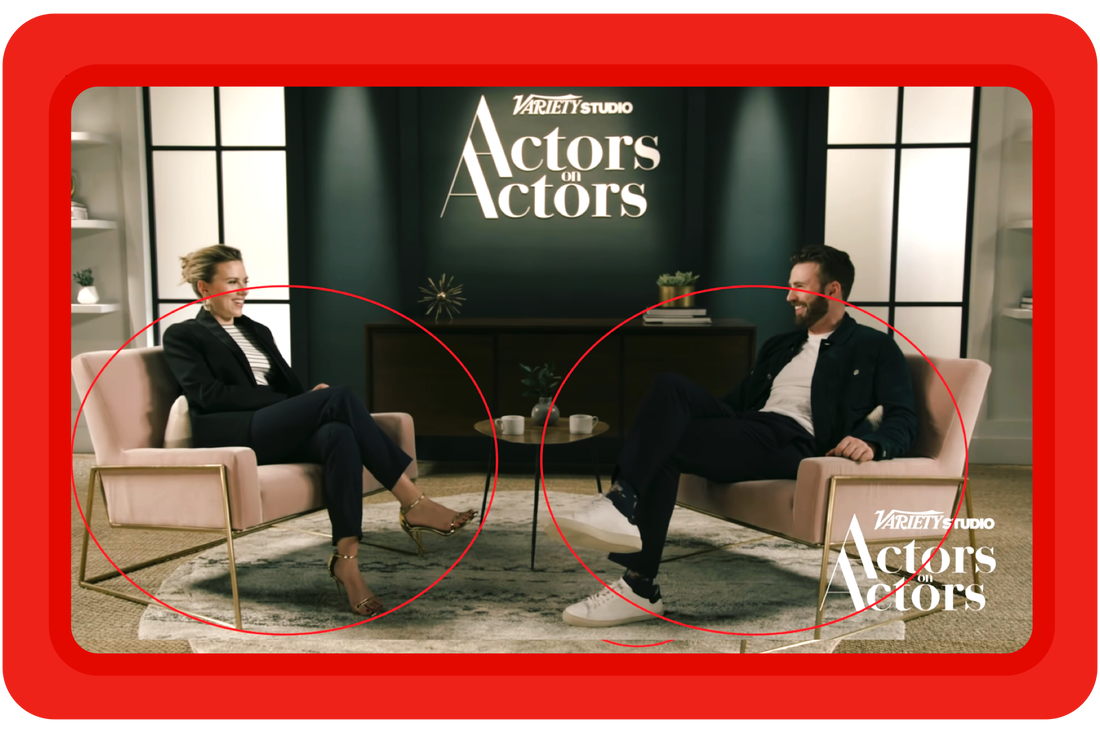
Mirroring Eye Contact
Eye contact is another factor to look for. Is the other person making sustained eye contact with you?
Sustained eye contact with another person releases Oxytocin in the brain, and is a great indicator that the other person is enjoying their conversation with you.
Think of eye contact like a barometer for the conversation.
Eye contact shows the other person that you’re engaged in the conversation.
Look at the below image: we can tell that both people are engaged and mirroring one another because of their active eye contact.
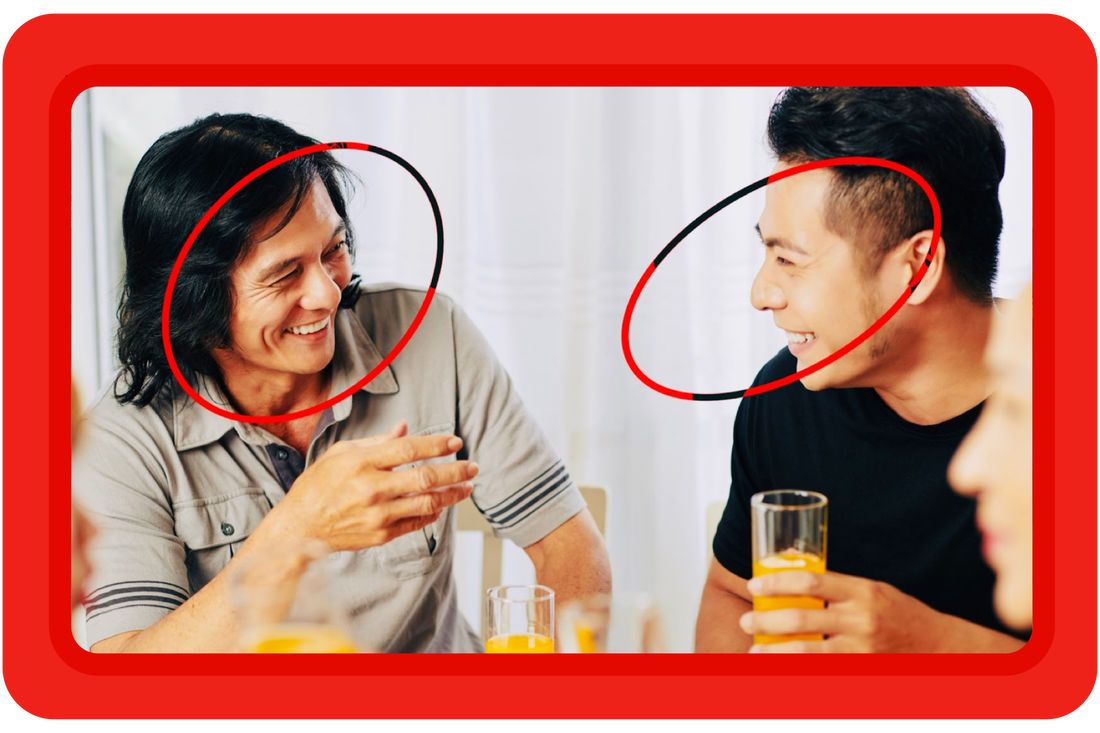
However, there’s a big catch!
Some people struggle with maintaining eye contact while talking, including people on the Autism and ADHD spectrums.
Additionally, too much eye contact can come across as creepy or aggressive, while too little eye contact can come across as overly weak or submissive.
And almost zero eye contact? That indicates strong disinterest in the conversation.
When listening, try to make eye contact or look at their forehead/tip of the nose if you’re struggling to think while making eye contact.
And above all else, don’t look at your watch!
Mirroring Gestures, Nods, and Facial Expressions
Some of us tend to talk with our hands, or use a knowing nod to convey information, or raise our eyebrows knowingly as an invitation to the other person.
This is a great opportunity for mirroring. When one of you gestures, what does the other person do?
Do you both sit rigidly, or are you both expressive with your hands? What about when one person smiles, does the other?
Take a look at this image of Sacha Baron Cohen and Don Cheadle.
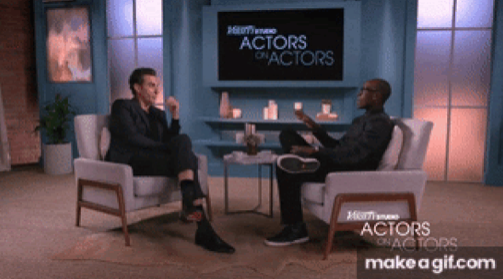
It’s about 17 minutes into their conversation (so rapport has been built), and both men are using similar types of gestures as they talk.
You can see Cohen wave his open palm around to demonstrate, and then Cheedle does the same thing with his palm facing himself. It’s not an exact mimicry, but the gestures are similar enough that it’s obvious that the two are in rapport.
Here’s another example where YouTubers Matti Haapoja and Peter McKinnon are in deep conversational rapport, and they’re both using pointing gestures in a subtle example of mirroring.
Not sure if this is mirroring?
Well, check this out… Both men also have their eyebrows raised and are making eye contact! #Clusters!
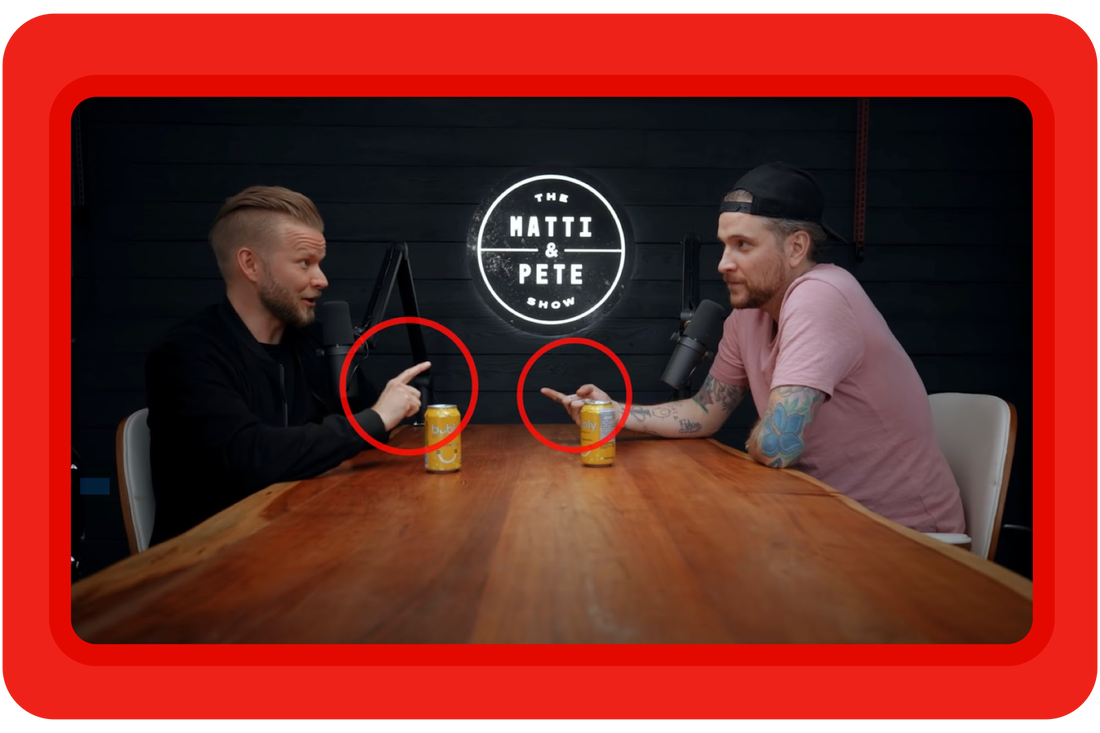
Mirroring Overall Energy Level
Have you ever been in a conversation with someone whose energy just… Didn’t match yours?
Maybe they were exuberantly enthusiastic and you were more withdrawn, or the roles are reversed.
Or perhaps you’ve been around someone with particularly “addictive” energy, and you noticed that your mood shifted to mirror those.
Energy level (and cadence) are slightly harder to observe, yet can provide the biggest evidence that mirroring is happening!
Pay attention to any feelings of mismatch.
Are you bouncing off the walls while the other person raises an eyebrow at you, or are you withdrawn while the other person tries to get you amped?
If you’re interested in making a connection, match your conversation partner’s energy level.
Mimic the rhythm of your partner’s speech by echoing their speed and pauses.
We all like the sound of our own voice, after all!
Action step: The next time you’re in a conversation, try using any of these tips! Better yet, try mirroring others for a whole day, and notice how people respond.
Verbal Mirroring
You don’t only have to mirror body language. You can also mirror the word choice and phrases others use.
In fact, this is a powerful way to mirror, and could explain why friend groups develop so many insight jokes and similar phrases!
To see the power of verbal mirroring in high-stress situations, watch Chris Voss (hostage negotiator and author of Never Split the Difference) explain how verbal mirroring is one of his most useful negotiation tools.
These verbal mirroring tips are your quick-start guide to verbal mirroring! If someone uses a particular word to describe something, use that word too!
For example:
- “Ugh, my day was just horrendous. You won’t believe what happened…”
- “Wow, that does sound horrendous.”
And if someone has a go-to exclamation, mirror that language (like using the word “sweet!” when someone else does).
Watch for other people mirroring YOUR language.
This may mean they want to get to know you better, or that you’re already in rapport and you didn’t even know it.
And remember: verbal mirroring is not monkey-see-monkey-do!
You don’t want mirroring to be consciously noticed (and labeled as teasing!). We don’t want to remind people of the phrase “Teacher, they’re copying me!”
Action step: The best test for verbal mirroring is to try it where there’s no body language, so try it next time you make a call!
How to trigger rapport with mirroring using the mirror test
Okay, so now you know all about mirroring.
But how can you use this skill to give you information, rather than just subtly make you more likeable?
This section will teach you how to use the mirror test to both assess and trigger rapport. It’s a heck of a lot easier than mastering telepathy before your next interview.
Here’s how to try the mirror test:
- Take a beat and look for examples of mirroring. For example:
- Does the other person take a drink when you do?
- Does the other person shift their body position when you do?
- Does the other person smile when you do?
- If you don’t see any mirroring, then you can jumpstart the mirroring process!
- When they take a drink, you do too.
- When they lean forward or back, you (subtly) do too.
- When they smile, you do too.
- Continue mirroring and observing for the next minute. If they start to mirror you, you’ve established rapport! If they don’t… Well, you just learned some valuable information!
You can expect a slight “lag” in mirroring, according to Dr. Jack Schafer.
He suggests waiting at least 20 to 30 seconds in order to see if the other person starts to mirror you.
If they don’t mirror you yet, no sweat! Schafer recommends finding some more common ground with the other person and continuing to build rapport.
Once you notice mirroring, you’re golden!
Action step: Try the mirror test out in a low-pressure situation with a new person, like a happy hour or idle conversation before a meeting.
(Maybe avoid the mirror test in the interview for your dream job until you’re a mirroring expert!)
How to use mirroring in daily interactions (Do this, not that.)
Do...
- At dinner: Take a sip of your drink when they do.
- At a meeting: Lean your elbows on the table when they do.
- If you notice them scratch their head, make a similar gesture. (Remember-no need to mimic exactly!)
- Hanging out with friends: Use a similar expression that they use.
- At lunch, begin to get ready to leave when you see them glance at their watch
Don’t...
- At dinner: Take a sip of your drink EVERY time they do.
- At a meeting: Lean your elbows on the table EVERY time they do.
- If you notice them scratch their head, make the EXACT same gesture.
- Hanging out with friends: Use similar expressions that they use 100% of the time.
- At lunch, copy all of their actions as they pack up their trash to throw away.
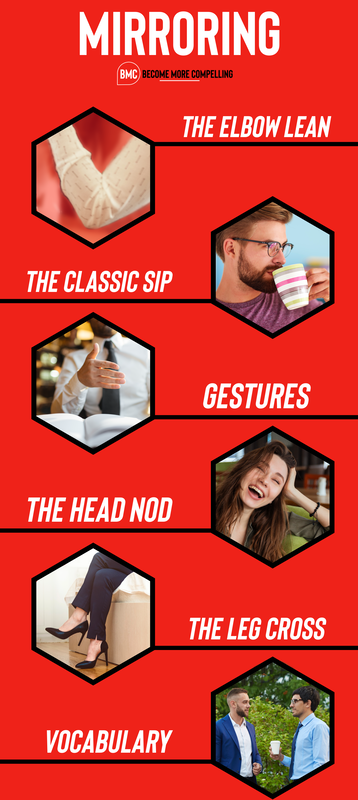
Mirroring: Action Step Summary
- Go observe mirroring in the “wild,” like between couples at restaurants. Who is mirroring whom?
- Remember to “front” before mirroring– face your partner, and use open body language.
- Try a “mirroring day,” where you mirror everyone you meet!
- Try verbal mirroring during a customer service phone call. Can you change the tone of the conversation?
- Try out the “mirror test” in a low-stakes interaction!
Next Step:
Want more tips to help you improve your people skills?
Click the blue button below!
I'll send you my free 56-minute audio guide on joining and enjoying group conversations. (As well as Q&A videos, podcast, and much more)
In the audio guide, you’ll learn…
- How to jump into a conversation that has no opening
- Genuinely Connect With Anyone About Any Topic
- How To Get Out Of Your Head And Stay Present In Group Conversations
- And more (word-for-word scripts, body language while joining a group, etc)
3 ways I can help you level up your communication skills:
1. Private Coaching: I’m the secret weapon top Performers at Google, Netflix, and the US Army trust for people skills coaching. Imagine what I can do for you.
2. Social Accelerator: Social Accelerator is my proven self-paced + group coaching system for turning social awkwardness into confidence, overthinking into action, and hesitation into meaningful connections.
3. My group convos audio guide. Join over 5,000 overthinkers who have supercharged their group conversation skills using tested strategies in my 56-minute audio training.

I'm Jeff Callahan
I make it nearly impossible for overthinkers to fail at improving their people skills. (I've helped hundreds of people over the last 10 years)
Want to never run out of things to say in conversation again so you connect with more people and make new friends?
Want to speak up more in important meetings at work so you get promoted faster and have an awesome career?
Want to develop unshakeable social confidence and competence so you can walk into any room and feel like you belong there?
As your coach, I'll help you move forward faster.






